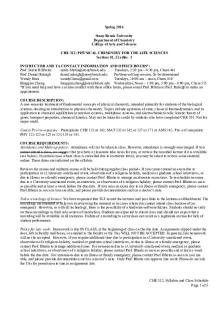Bystanderism PDF PDF

| Title | Bystanderism PDF |
|---|---|
| Course | IB Theory of Knowledge (TOK) |
| Institution | High School - USA |
| Pages | 2 |
| File Size | 25.2 KB |
| File Type | |
| Total Downloads | 64 |
| Total Views | 137 |
Summary
Assignment on Bystanderism done during distance learning, for Dr. Mooney, THHS...
Description
Dr. Mooney IB TOK HL 19 March 2020 Bystanderism “Nobody likes you! Life would be better without you, and your parents agree. Go to hell!” The little boy is knocked off his feet with the sweep of a sticky, dirty fist. He crumbles to the floor and his neck snaps backward, skull cracking against the pavement. Three bigger boys cackle in the distance as they scatter, leaving the little boy bewildered and in excruciating pain. Four onlookers sit silently by, wondering if anyone has the guts to do anything. “Aren’t you gonna help him?” “No… I thought you were.” The witnesses stay put. Not calling, not coddling, nothing. They fail to notice that the boy split his head open upon impact with the pavement. Hair matted with blood, he tries to lift his neck, but is too weak to do so. His last word- coincidentally his first as a toddler- is “mommy.” Three neighborhood bullies have succeeded in killing their weak little target in the presence for four other bystanders. Because nobody did shit. By definition, bystanderism is a phenomenon in which an individual is less likely to help another individual in an emergency situation when there are other people present. Two famous researchers who covered bystanderism are Darley and Batson (1973). They investigated the Good Samaritan parable by designing an experiment to test if participants would aid a stranger in need. Helping the stranger meant the participants would be late to their meeting, so they were sacrificing their self-image. The participants in the experiment were 40 male seminary students at Princeton Theological Seminary, studying to become ministers. Their religiosity was determined through a personal questionnaire. Participants passed a confederate “victim” in the alleyway on the way to their meeting. They were later asked the question “when was the last time you helped someone in need?” The experimenters found that helping was significantly influenced by the pressure of time. People not in a hurry were more likely to help. Those in a hurry were the least helpful.
Darley and Batson’s experiment was conducted in the field, which increases the ecological validity. Participants were also randomly allocated to the conditions of the experiment. One demand characteristic that might have been present in this experiment was the social desirability bias. Participants may have been more inclined to help the victim if they thought it meant others would like them more. The Hawthorne Effect might have also come into play if they thought others were watching them. Thus they should be obligated to help. One researcher bias might have been the confirmation bias. It seems obvious that individuals in a hurry would be much less likely to help the confederate than participants not in a hurry. Bystanderism is a common phenomenon that leads people to expect that others will step forward in a situation instead of them. It is what led to the eventual death of Kitty Genovese, who was not helped after being stabbed even though several people were present. The bystander effect is also the reason so many bullies get away with harassing kids. Someone always expects the next person to step up and do the right thing. Assuming someone else will be a Good Samaritan and help the victim does not solve a problem....
Similar Free PDFs

Bystanderism PDF
- 2 Pages

- 9 Pages

Common Good PDF - pdf
- 7 Pages

- 2 Pages

- 43 Pages

- 47 Pages

- 5 Pages

- 130 Pages

- 16 Pages

Pdf Daniel - pdf
- 223 Pages

Keselamatan_Maritim_2.pdf
- 147 Pages

arens_auditing_14ce_ism_c18.pdf
- 25 Pages

Pdfcoffee - Pdf
- 39 Pages

Τσάμηδες PDF
- 8 Pages
Popular Institutions
- Tinajero National High School - Annex
- Politeknik Caltex Riau
- Yokohama City University
- SGT University
- University of Al-Qadisiyah
- Divine Word College of Vigan
- Techniek College Rotterdam
- Universidade de Santiago
- Universiti Teknologi MARA Cawangan Johor Kampus Pasir Gudang
- Poltekkes Kemenkes Yogyakarta
- Baguio City National High School
- Colegio san marcos
- preparatoria uno
- Centro de Bachillerato Tecnológico Industrial y de Servicios No. 107
- Dalian Maritime University
- Quang Trung Secondary School
- Colegio Tecnológico en Informática
- Corporación Regional de Educación Superior
- Grupo CEDVA
- Dar Al Uloom University
- Centro de Estudios Preuniversitarios de la Universidad Nacional de Ingeniería
- 上智大学
- Aakash International School, Nuna Majara
- San Felipe Neri Catholic School
- Kang Chiao International School - New Taipei City
- Misamis Occidental National High School
- Institución Educativa Escuela Normal Juan Ladrilleros
- Kolehiyo ng Pantukan
- Batanes State College
- Instituto Continental
- Sekolah Menengah Kejuruan Kesehatan Kaltara (Tarakan)
- Colegio de La Inmaculada Concepcion - Cebu

![[PDF] Cours complet marketing en PDF Télécharger PDF](https://pdfedu.com/img/crop/172x258/gwrwp9kme218.jpg)